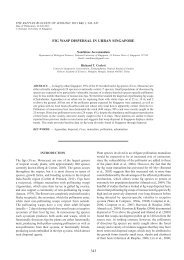1O257LF
1O257LF
1O257LF
You also want an ePaper? Increase the reach of your titles
YUMPU automatically turns print PDFs into web optimized ePapers that Google loves.
© 2010 Dinosauria International Ten Sleep Report Series No. 1<br />
SYSTEMATIC PALEONTOLOGY<br />
Order SAURISCHIA<br />
Suborder SAUROPODOMORPHA<br />
Family DIPLODOCIDAE<br />
Genus: Amphicoelias Cope 1877<br />
Type species: Amphicoelias altus Cope<br />
Included species: Amphicoelias altus, A. “brontodiplodocus”<br />
and A. emilieae<br />
Type Locality: Morrison Formation, Quarry 12, Garden<br />
Park, Colorado<br />
Synonyms: Apatosaurus Marsh, Barosaurus Marsh,<br />
Diplodocus Marsh, Seismosaurus Gillette, Eobrontosaurus<br />
Filla and Redman, Supersaurus Jensen, and Suuwassea<br />
Harris and Dodson<br />
Emended diagnosis: Amphicoelias differs from all other<br />
diplodocids in the extreme microcephalomorph condition<br />
of the skull in relation to the length of the axial skeleton in<br />
mature individuals. In comparison to other sauropods, the<br />
skull in Amphicoelias has proportionately the longest rostrum<br />
relative to the post-orbital length. Thus, the premaxillae are<br />
caudally elongated and the anterior-posterior length of the<br />
nasal and frontal bones are reduced and receded, more so than<br />
in other sauropods. The Amphicoelias skull is characterized<br />
by a rostral crest formed by the caudal processes of the<br />
premaxillae (autapomorphy), and with the premaxillae<br />
and maxillae transversely extended and flattened forming<br />
a duck billed shaped rostrum. Presence of the external<br />
narial openings located posterior-dorsal almost above orbits<br />
(synapomorphy). Amphicoelias differs from all sauropods<br />
in the development of an interfenestra bridge dividing the<br />
preantorbital from the antorbital fenestrae (autapomorphy).<br />
In Amphicoelias, Nigersaurus, and Tornieria the preantorbital<br />
fenestrae are positioned immediately behind the last<br />
maxillary tooth. There are two preantorbital openings<br />
present in the maxilla of Nemegtosaurus distinguishing it from<br />
Amphicoelias Pterygoid bones in Amphicoelias are sagitally<br />
positioned at a steep angle in comparison to other known<br />
sauropod skulls. Amphicoelias shares with the diplodocid<br />
genera Tornieria, and Dicraeosaurus, the following derived<br />
sauropod characters: occipital condyle ventrally positioned;<br />
quadrates rostroventrally inclined; basipterygoid processes<br />
slender, elongate and oriented rostroventrally; and jaws<br />
behind preantorbital fenestra are without teeth.<br />
As in all diplodocids the dentition is homodont, with both<br />
crown and roots shaped almost into long slender cylindrical<br />
rods. Upper and lower teeth are replaced in crowded<br />
overlapping successional rows. The crowns in unworn teeth<br />
are slightly compressed labially and taper towards the apex.<br />
The teeth are spaced apart, and project forward in contrast<br />
to the unique transversely arranged dental battery present in<br />
Nigersaurus. The mandible is long and slender with ventrally<br />
expanded symphysis, and as in all sauropods the articular<br />
joint is positioned lower than level of its dentition.<br />
Axial skeleton: There are fifteen cervical, ten dorsal, five<br />
sacral, and 80 plus caudal vertebrae. Based on cervical<br />
and caudal vertebral lengths, Amphicoelias represents the<br />
longest sauropod in regards to absolute body length. There<br />
are fifteen cervical vertebrae, which in length of centrum<br />
increase from C 1- 14, and then reducing at C 15. Hence,<br />
the longest cervical and longest presacral vertebra is C 14.<br />
Neural spine bifurcation in cervicals start at C 3 in A. altus<br />
and C 9 in A. "brontodiplodocus" C 14-15 represent modified<br />
dorsal vertebra which are autapomorphies of Amphicoelias<br />
C 2- 15 are opisthocoelous.<br />
There are ten rib bearing dorsals, the anterior four are<br />
opisthocoelous while the posterior ones are amphicoelous.<br />
The 1 st dorsal has the longest centrum. The neural spine<br />
of the tenth, or last free dorsal, is off alignment from its<br />
long axis, therefore, is not positioned perpendicular to the<br />
centrum as in the other preceding dorsals. There are no<br />
complete presacral series in other recognized diplodocids to<br />
compare with these derived Amphicoelias characters.<br />
Sacral vertebrae can fuse in juveniles half the size of adults.<br />
The sacrum in adults is normally comprised of one dorsal, two<br />
sacral and two caudal vertebrae. Posterior dorsals, sacrum,<br />
and anterior caudal vertebrae all have comparatively well<br />
developed taller neural spines. The sacral vertebrae centra<br />
have ventral keels, which are less pronounced in males.<br />
Amphicoelias is readily distinguished from other sauropods<br />
in the caudal vertebrae not only in its combined absolute<br />
length but also in the unique and complex morphology.<br />
Complete caudal vertebrae are not known in closely<br />
related taxa (Amargasaurus, Dicraeosaurus, Nigersaurus, and<br />
Rebbachisaurus). Thus, the following combined characters<br />
are considered autapomorphy of Amphicoelias. Except<br />
for the biconvex centra of the whiptail caudals, all centra<br />
are procoelous. Anterior caudals are short, broad, and<br />
possess pleurocoels (suppressed or absent in males) with<br />
dorsoventrally expanded transverse processes. The centra<br />
of anterior caudals gradually decrease in size posteriorly.<br />
At a mid-point, they increase in length and robustness<br />
from Cd 16-20 (hypertrophy) before decreasing again in<br />
size where they meet the supernumerary whiplash series.<br />
The approximately forty or so supernumerary caudals are<br />
subequal in length, elongate, cylindrical, slender and simple<br />
in structure. The location of hypertrophic transitional series<br />
is variable. Caudal fusion is also variable depending on the<br />
individual and age, and can occur singly or in sets of two.<br />
6



